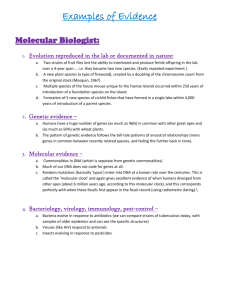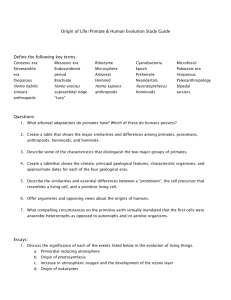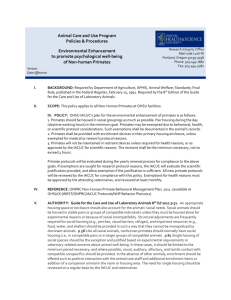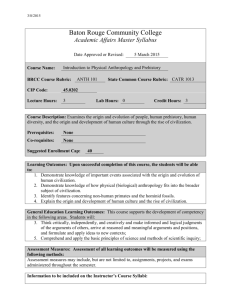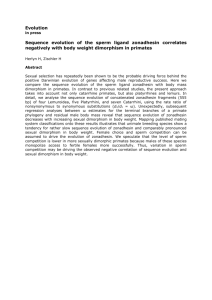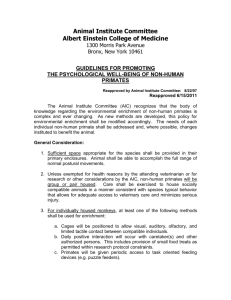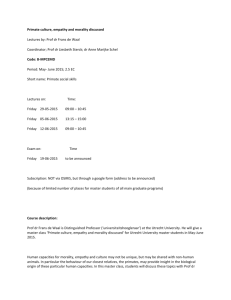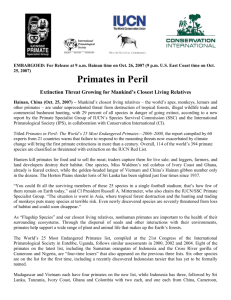Chapter 6 notes
advertisement
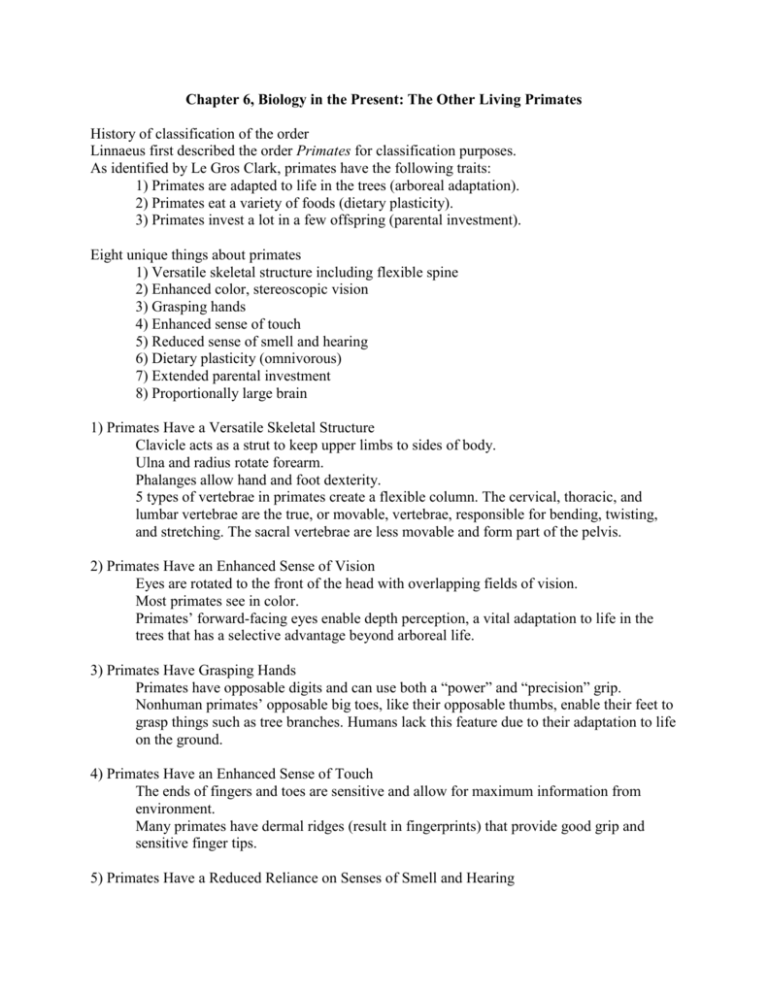
Chapter 6, Biology in the Present: The Other Living Primates History of classification of the order Linnaeus first described the order Primates for classification purposes. As identified by Le Gros Clark, primates have the following traits: 1) Primates are adapted to life in the trees (arboreal adaptation). 2) Primates eat a variety of foods (dietary plasticity). 3) Primates invest a lot in a few offspring (parental investment). Eight unique things about primates 1) Versatile skeletal structure including flexible spine 2) Enhanced color, stereoscopic vision 3) Grasping hands 4) Enhanced sense of touch 5) Reduced sense of smell and hearing 6) Dietary plasticity (omnivorous) 7) Extended parental investment 8) Proportionally large brain 1) Primates Have a Versatile Skeletal Structure Clavicle acts as a strut to keep upper limbs to sides of body. Ulna and radius rotate forearm. Phalanges allow hand and foot dexterity. 5 types of vertebrae in primates create a flexible column. The cervical, thoracic, and lumbar vertebrae are the true, or movable, vertebrae, responsible for bending, twisting, and stretching. The sacral vertebrae are less movable and form part of the pelvis. 2) Primates Have an Enhanced Sense of Vision Eyes are rotated to the front of the head with overlapping fields of vision. Most primates see in color. Primates’ forward-facing eyes enable depth perception, a vital adaptation to life in the trees that has a selective advantage beyond arboreal life. 3) Primates Have Grasping Hands Primates have opposable digits and can use both a “power” and “precision” grip. Nonhuman primates’ opposable big toes, like their opposable thumbs, enable their feet to grasp things such as tree branches. Humans lack this feature due to their adaptation to life on the ground. 4) Primates Have an Enhanced Sense of Touch The ends of fingers and toes are sensitive and allow for maximum information from environment. Many primates have dermal ridges (result in fingerprints) that provide good grip and sensitive finger tips. 5) Primates Have a Reduced Reliance on Senses of Smell and Hearing Most higher primates have lost the naked rhinarium (wet nose). Some prosimians retain the rhinarium. Smell is a secondary sense in most primates. Primates have reduced sense of smell. Snout size indicates general reliance on smell. 6) Dietary Plasticity—Primates Eat a Highly Varied Diet, and Their Teeth Reflect This Adaptive Versatility Primates Have Retained Primitive Characteristics in Their Teeth Dental traits in four functionally distinct tooth types Primates Have a Reduced Number of Teeth Dental formula records number of teeth in one jaw quadrant. 2/1/2/3 is the formula for Old World monkeys and apes. 2/1/3/3 is the formula for New World monkeys. Primates Have Evolved Different Dental Specializations and Functional Emphases Premolars and molars used for grinding. Molars have different numbers of cusps. Bilophodont (two lobes). Y-5 (cusps in the shape of a “Y”). Canine-premolar honing complex slices food. Enamel thickness varies across order. The sagittal crest is used for masticatory muscle attachment. The larger the crest, the stronger the chewing potential. 7) Parental Investment—Primate Parents Provide Prolonged Care for Fewer, but Smarter, More Socially Complex, and Longer-Lived Offspring Female primates give birth to fewer offspring than other mammals. Investment in offspring is high. Development period is longer, especially in apes. 8) Proportionally Large Brain Development period is related to larger brain size in primates. Humans have the largest brain for body size. Primates with the greatest body mass also have the greatest brain mass and thus the greatest intelligence. Most primates also have a larger brain relative to body size than the average mammal, a reflection of primates’ higher intelligence. Over two hundred species of primates with great physical and behavioral diversity Differences have occurred through evolution. Living primates provide models for understanding evolutionary past. Genetic vs. Anatomical Classification DNA analysis demonstrates humans, gorillas, chimpanzees and bonobos are more closely related than each is to orangutans. Chimpanzees and humans are more closely related than either is to gorillas. DNA analyses (genetic classification) provide a different window to the relationships between primates from anatomical classification, which provides insight into adaptations. Our textbook uses anatomical classification. Prosimians: The Lesser Primates Among oldest living primates Developed sense of smell Combination of nails and claws with less dexterity than other primates Geographic range: Madagascar and Southeast Asia Tarsiers share some traits with prosimians and anthropoids Anthropoids: The Higher Primates Old World monkeys (catarrhines) Nostrils separated by a septum that points downward Most diverse and most successful nonhuman primates Tough sitting pads on the rear (ischial callosities) Inhabit terrestrial and arboreal habitats in Africa and Asia Two subfamilies: cercophithecoids and colobines Baboons, macaques, mandrills, colobus New World monkeys (platyrrhines) Rounded nostrils separated by a septum Prehensile tail Inhabit arboreal habitats in Latin America One subfamily: ceboids Spider, squirrel, howler monkeys Hominoids Great Apes: orangutan, chimpanzee, bonobo, gorilla Sagittal crest in gorilla, orangutan Chimpanzees omnivorous Humans characterized by skeletal structure for bipedalism Lesser apes: gibbon, siamang Skilled brachiators
